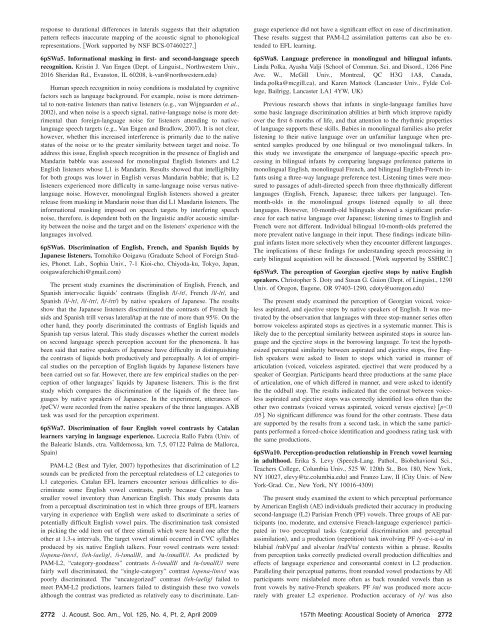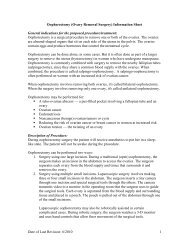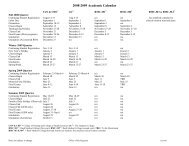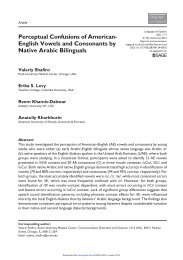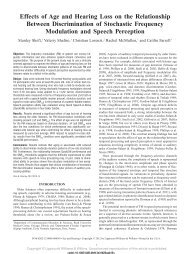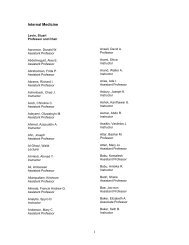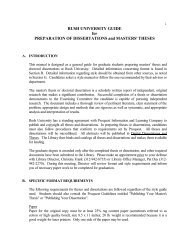Perceptual confusions of American English vowels ... - Rush University
Perceptual confusions of American English vowels ... - Rush University
Perceptual confusions of American English vowels ... - Rush University
Create successful ePaper yourself
Turn your PDF publications into a flip-book with our unique Google optimized e-Paper software.
esponse to durational differences in laterals suggests that their adaptation<br />
pattern reflects inaccurate mapping <strong>of</strong> the acoustic signal to phonological<br />
representations. Work supported by NSF BCS-07460227.<br />
6pSWa5. Informational masking in first- and second-language speech<br />
recognition. Kristin J. Van Engen Dept. <strong>of</strong> Linguist., Northwestern Univ.,<br />
2016 Sheridan Rd., Evanston, IL 60208, k-van@northwestern.edu<br />
Human speech recognition in noisy conditions is modulated by cognitive<br />
factors such as language background. For example, noise is more detrimental<br />
to non-native listeners than native listeners e.g., van Wijngaarden et al.,<br />
2002, and when noise is a speech signal, native-language noise is more detrimental<br />
than foreign-language noise for listeners attending to nativelanguage<br />
speech targets e.g., Van Engen and Bradlow, 2007. It is not clear,<br />
however, whether this increased interference is primarily due to the native<br />
status <strong>of</strong> the noise or to the greater similarity between target and noise. To<br />
address this issue, <strong>English</strong> speech recognition in the presence <strong>of</strong> <strong>English</strong> and<br />
Mandarin babble was assessed for monolingual <strong>English</strong> listeners and L2<br />
<strong>English</strong> listeners whose L1 is Mandarin. Results showed that intelligibility<br />
for both groups was lower in <strong>English</strong> versus Mandarin babble; that is, L2<br />
listeners experienced more difficulty in same-language noise versus nativelanguage<br />
noise. However, monolingual <strong>English</strong> listeners showed a greater<br />
release from masking in Mandarin noise than did L1 Mandarin listeners. The<br />
informational masking imposed on speech targets by interfering speech<br />
noise, therefore, is dependent both on the linguistic and/or acoustic similarity<br />
between the noise and the target and on the listeners’ experience with the<br />
languages involved.<br />
6pSWa6. Discrimination <strong>of</strong> <strong>English</strong>, French, and Spanish liquids by<br />
Japanese listeners. Tomohiko Ooigawa Graduate School <strong>of</strong> Foreign Studies,<br />
Phonet. Lab., Sophia Univ., 7-1 Kioi-cho, Chiyoda-ku, Tokyo, Japan,<br />
ooigawaferchichi@gmail.com<br />
The present study examines the discrimination <strong>of</strong> <strong>English</strong>, French, and<br />
Spanish intervocalic liquids’ contrasts <strong>English</strong> /l/-/r/, French /l/-/r/, and<br />
Spanish /l/-/r/, /l/-/rr/, /l/-/rr/ by native speakers <strong>of</strong> Japanese. The results<br />
show that the Japanese listeners discriminated the contrasts <strong>of</strong> French liquids<br />
and Spanish trill versus lateral/tap at the rate <strong>of</strong> more than 95%. On the<br />
other hand, they poorly discriminated the contrasts <strong>of</strong> <strong>English</strong> liquids and<br />
Spanish tap versus lateral. This study discusses whether the current models<br />
on second language speech perception account for the phenomena. It has<br />
been said that native speakers <strong>of</strong> Japanese have difficulty in distinguishing<br />
the contrasts <strong>of</strong> liquids both productively and perceptually. A lot <strong>of</strong> empirical<br />
studies on the perception <strong>of</strong> <strong>English</strong> liquids by Japanese listeners have<br />
been carried out so far. However, there are few empirical studies on the perception<br />
<strong>of</strong> other languages’ liquids by Japanese listeners. This is the first<br />
study which compares the discrimination <strong>of</strong> the liquids <strong>of</strong> the three languages<br />
by native speakers <strong>of</strong> Japanese. In the experiment, utterances <strong>of</strong><br />
/peCV/ were recorded from the native speakers <strong>of</strong> the three languages. AXB<br />
task was used for the perception experiment.<br />
6pSWa7. Discrimination <strong>of</strong> four <strong>English</strong> vowel contrasts by Catalan<br />
learners varying in language experience. Lucrecia Rallo Fabra Univ. <strong>of</strong><br />
the Balearic Islands, ctra. Valldemossa, km. 7,5, 07122 Palma de Mallorca,<br />
Spain<br />
PAM-L2 Best and Tyler, 2007 hypothesizes that discrimination <strong>of</strong> L2<br />
sounds can be predicted from the perceptual relatedness <strong>of</strong> L2 categories to<br />
L1 categories. Catalan EFL learners encounter serious difficulties to discriminate<br />
some <strong>English</strong> vowel contrasts, partly because Catalan has a<br />
smaller vowel inventory than <strong>American</strong> <strong>English</strong>. This study presents data<br />
from a perceptual discrimination test in which three groups <strong>of</strong> EFL learners<br />
varying in experience with <strong>English</strong> were asked to discriminate a series <strong>of</strong><br />
potentially difficult <strong>English</strong> vowel pairs. The discrimination task consisted<br />
in picking the odd item out <strong>of</strong> three stimuli which were heard one after the<br />
other at 1.3-s intervals. The target vowel stimuli occurred in CVC syllables<br />
produced by six native <strong>English</strong> talkers. Four vowel contrasts were tested:<br />
//opena-/invv/, //eh-/aelig/, /i-/smallI/, and /u-/smallU/. As predicted by<br />
PAM-L2, “category-goodness” contrasts /i-/smallI/ and /u-/smallU/ were<br />
fairly well discriminated, the “single-category” contrast /opena-/invv/ was<br />
poorly discriminated. The “uncategorized” contrast //eh-/aelig/ failed to<br />
meet PAM-L2 predictions, learners failed to distinguish these two <strong>vowels</strong><br />
although the contrast was predicted as relatively easy to discriminate. Language<br />
experience did not have a significant effect on ease <strong>of</strong> discrimination.<br />
These results suggest that PAM-L2 assimilation patterns can also be extended<br />
to EFL learning.<br />
6pSWa8. Language preference in monolingual and bilingual infants.<br />
Linda Polka, Ayasha Valji School <strong>of</strong> Commun. Sci. and Disord., 1266 Pine<br />
Ave. W., McGill Univ., Montreal, QC H3G 1A8, Canada,<br />
linda.polka@mcgill.ca, and Karen Mattock Lancaster Univ., Fylde College,<br />
Bailrigg, Lancaster LA1 4YW, UK<br />
Previous research shows that infants in single-language families have<br />
some basic language discrimination abilities at birth which improve rapidly<br />
over the first 6 months <strong>of</strong> life, and that attention to the rhythmic properties<br />
<strong>of</strong> language supports these skills. Babies in monolingual families also prefer<br />
listening to their native language over an unfamiliar language when presented<br />
samples produced by one bilingual or two monolingual talkers. In<br />
this study we investigate the emergence <strong>of</strong> language-specific speech processing<br />
in bilingual infants by comparing language preference patterns in<br />
monolingual <strong>English</strong>, monolingual French, and bilingual <strong>English</strong>-French infants<br />
using a three-way language preference test. Listening times were measured<br />
to passages <strong>of</strong> adult-directed speech from three rhythmically different<br />
languages <strong>English</strong>, French, Japanese; three talkers per language. Tenmonth-olds<br />
in the monolingual groups listened equally to all three<br />
languages. However, 10-month-old bilinguals showed a significant preference<br />
for each native language over Japanese; listening times to <strong>English</strong> and<br />
French were not different. Individual bilingual 10-month-olds preferred the<br />
more prevalent native language in their input. These findings indicate bilingual<br />
infants listen more selectively when they encounter different languages.<br />
The implications <strong>of</strong> these findings for understanding speech processing in<br />
early bilingual acquisition will be discussed. Work supported by SSHRC.<br />
6pSWa9. The perception <strong>of</strong> Georgian ejective stops by native <strong>English</strong><br />
speakers. Christopher S. Doty and Susan G. Guion Dept. <strong>of</strong> Linguist., 1290<br />
Univ. <strong>of</strong> Oregon, Eugene, OR 97403-1290, cdoty@uoregon.edu<br />
The present study examined the perception <strong>of</strong> Georgian voiced, voiceless<br />
aspirated, and ejective stops by native speakers <strong>of</strong> <strong>English</strong>. It was motivated<br />
by the observation that languages with three stop-manner series <strong>of</strong>ten<br />
borrow voiceless aspirated stops as ejectives in a systematic manner. This is<br />
likely due to the perceptual similarity between aspirated stops in source language<br />
and the ejective stops in the borrowing language. To test the hypothesized<br />
perceptual similarity between aspirated and ejective stops, five <strong>English</strong><br />
speakers were asked to listen to stops which varied in manner <strong>of</strong><br />
articulation voiced, voiceless aspirated, ejective that were produced by a<br />
speaker <strong>of</strong> Georgian. Participants heard three productions at the same place<br />
<strong>of</strong> articulation, one <strong>of</strong> which differed in manner, and were asked to identify<br />
the the oddball stop. The results indicated that the contrast between voiceless<br />
aspirated and ejective stops was correctly identified less <strong>of</strong>ten than the<br />
other two contrasts voiced versus aspirated, voiced versus ejective p0<br />
.05. No significant difference was found for the other contrasts. These data<br />
are supported by the results from a second task, in which the same participants<br />
performed a forced-choice identification and goodness rating task with<br />
the same productions.<br />
6pSWa10. Perception-production relationship in French vowel learning<br />
in adulthood. Erika S. Levy Speech-Lang. Pathol., Biobehavioral Sci.,<br />
Teachers College, Columbia Univ., 525 W. 120th St., Box 180, New York,<br />
NY 10027, elevy@tc.columbia.edu and Franzo Law, II City Univ. <strong>of</strong> New<br />
York-Grad. Ctr., New York, NY 10016-4309<br />
The present study examined the extent to which perceptual performance<br />
by <strong>American</strong> <strong>English</strong> AE individuals predicted their accuracy in producing<br />
second-language L2 Parisian French PF <strong>vowels</strong>. Three groups <strong>of</strong> AE participants<br />
no, moderate, and extensive French-language experience participated<br />
in two perceptual tasks categorial discrimination and perceptual<br />
assimilation, and a production repetition task involving PF /y-œ-i-a-u/ in<br />
bilabial /rabVpa/ and alveolar /radVta/ contexts within a phrase. Results<br />
from perception tasks correctly predicted overall production difficulties and<br />
effects <strong>of</strong> language experience and consonantal context in L2 production.<br />
Paralleling their perceptual patterns, front rounded vowel productions by AE<br />
participants were mislabeled more <strong>of</strong>ten as back rounded <strong>vowels</strong> than as<br />
front <strong>vowels</strong> by native-French speakers. PF /œ/ was produced more accurately<br />
with greater L2 experience. Production accuracy <strong>of</strong> /y/ was also<br />
2772 J. Acoust. Soc. Am., Vol. 125, No. 4, Pt. 2, April 2009 157th Meeting: Acoustical Society <strong>of</strong> America 2772


